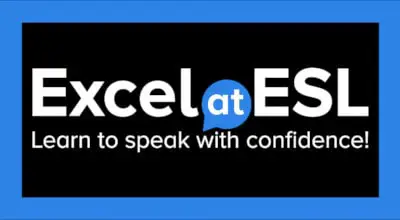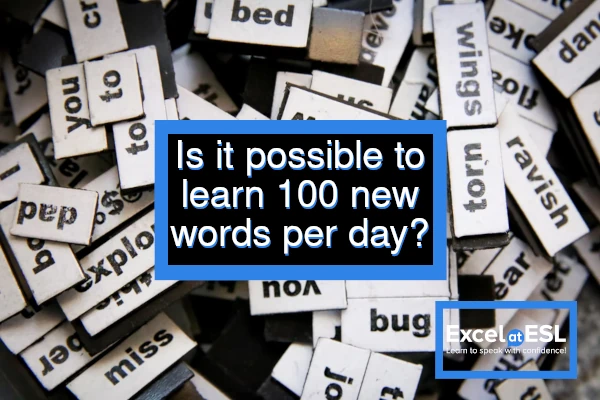We’ve all experienced the rush of willpower and motivation that comes along with learning a new language. When we first start, learning is fun and exciting! Our minds swim with the possibility of speaking in a new language, interacting with native speakers, and maybe even living abroad. We want to achieve these goals as fast as possible, so you may ask yourself, “How many words can I learn in a day?”
It’s completely possible to learn 100 new words per day, but is that the most effective strategy? Learning a language is a life-long journey. You need to develop sustainable language habits to achieve your goals.
How Many Words Can I Learn in a Day?
The answer to this question isn’t as simple as you might think. There are a lot of smaller questions that go in to answering this larger one. It’s easy to get lost in our initial enthusiasm for learning. And why not? It’s a great opportunity to leverage your motivation and excitement for some early gains. But, let’s explore this question in more depth. If you want some strategies to enhance your daily English learning, check out my article “How to Improve Your English Day by Day”.
How many languages do you already know?
A large contributor to the number of words you can pick up in a day are the languages you already speak. Some languages are more similar than others. For example, European languages all have a common ancestor. Languages like French, Italian, Spanish, Romanian, Portuguese, and many others all descended from Latin. This means that all of these languages were the same hundreds of years ago.
This extends even further into the past. Did you know that every European language is related? Proto-Indo-European is the ancestor language to every European language (and some Asian languages too!) from English to Russian, Hindi to Persian, and everything in between.
This ancestry means that these languages share many common words. Knowledge in one language makes it easier to learn another. You can leverage this knowledge to learn more words in a day than if you didn’t have this knowledge.
Of course, this doesn’t apply to every language on Earth, but it’s a good starting point. Previously acquired knowledge is one of the greatest assets for continued learning.
What does it mean to “know” a word?
If you want to learn 100 new words every day, what does that mean? When do you know a word? Is it when you can recognize the word in one sentence? In many sentences? Or is it when you can use the word yourself?
This isn’t an easy distinction to make and many people have different ideas about what it means to “know” a word.
Passive Vocabulary
Adding a word to your passive vocabulary is one way to know it.
Your passive vocabulary is the collection of words you can recognize while reading or listening to a language. As you spend time studying your target language, you will begin to accumulate an increasing number of words in your passive vocabulary.
Active Vocabulary
This is the opposite of your passive vocabulary.
Words that you are able to use while speaking or writing are part of your active vocabulary.
Making Passive Vocabulary Active
So this begs the question, how can we make our passive vocabulary active?
The most important thing to understand is your active vocabulary will never be larger than your passive vocabulary. If you think about it, this makes sense. In order for a word to become active in our vocabulary it needs to pass through our passive vocabulary first. How can you use a word if you don’t know what it means?
This means that the most efficient way to grow your active vocabulary is to grow your passive vocabulary. As you learn more words, you will be able use more words as well.
You shouldn’t get caught up on how large your active vocabulary is. Words pass naturally from passive to active as we continue to spend time with a language. This isn’t a process you can force. If you aren’t comfortable with the meaning and usage of a word, you aren’t going to use it. If you try to force yourself to use unfamiliar words, you end up sounding weird. This doesn’t mean you shouldn’t experiment with new words in the languages you’re learning, but you shouldn’t feel pressured or forced to use unfamiliar words.
Why is this the Wrong Question to Ask?
By now you’ve probably caught on, “can I learn 100 new words per day?” isn’t the question you should be asking. There are multiple reasons for this.
What do you mean when you say learn? What do you mean when you say word?
Memory isn’t a single binary concept. There is short term memory and long term memory. Sometimes, we even forget things that we definitely know only to have them come back to us later. So, learning a new word doesn’t only mean memorizing. Additionally, words come in many different forms and possess many different meanings. You can know the meaning of a word in one context, but not others. Does this mean you know the word if you can use it sometimes?
It isn’t enough to merely memorize words in isolation. This doesn’t give us enough information about how a word is used to effectively recognize or use the word ourselves. Language is a tool that we use to communicate ideas. Normally, ideas extend beyond single words. We need to understand the context of words too. I go into more depth about learning vocabulary in context in my article, “How to Learn English Vocabulary”.
Additionally, anyone with experience taking tests in school knows that rote memorization doesn’t last long. You might be able to cram information into your brain for a week or a month, but this quickly fades. Information learned this way isn’t important to you. You don’t form lasting connections in your brain to information when you try to force it. You need to build up connections through various pathways. Regularly engaging with a language in meaningful ways is more effective than flash card drills. This reinforces information in your brain and enhances your understanding and ability to recall information learned in this way.
Frankly, it’s a waste of your time to try and forcefully memorize new words. There are many learning strategies available to you which make learning easier, more fun, and more sustainable.
How can I make language learning sustainable?
Modern spaced repetition systems (such as Anki, a flash card application) are built on the understanding that repetition is fundamental to memorization.
But are flashcards the only way to achieve repetition? Of course not!
Language is built on patterns. For example, the word “friend” is a much more common English word than the word “hexadecimal”. However, if you’re studying computer science, you will come across the word “hexadecimal” more often than the word “friend”. Commonality and repetition depend on the type of material we are consuming.
So instead of relying on the repetition of flash card systems, you should be seeking repetition in your everyday interactions with your target language. This has two major benefits.
It’s more fun
Almost everyone has had the experience of using a flash card program and eventually needing to review hundreds of flash cards every day to maintain their learning pace. This isn’t fun. I don’t know anyone who wakes up in the morning and is excited to review their 500 flash card Anki deck.
However, there are plenty of people who wake up excited to watch a new movie or TV show, play a new video game, or read a new book.
You get valuable context information.
When you learn through direct contact with a language, you receive all of the information a flash card can’t give you. You learn about the environment a word appears in (what words frequently appear alongside the target word) and how it’s naturally used by native speakers.
Engaging with material we find enjoyable teaches us words we want to know and makes it more likely for us to continue our studies into the future.
Learn like a Baby
When you learned your first language, did you sit down every day and go over flash cards or read word lists over and over again? Of course not. Nobody learns their first language like this, so why learn a foreign one this way?
Children learn language by engaging with it daily. They need to or they wouldn’t survive. You need to use language to interact with your parents and friends, to learn new things at school, and express your needs and desires.
During their daily use, they encounter repetition constantly. The same situations happen every day in daily life. As they grow and develop interests, their interactions with their hobbies bring them into contact with the same vocabulary every day too.
Manage Your Motivation
No one feels motivated and excited to study languages every single day. Sometimes things get in the way of our study plans, we feel under the weather, or any other situation that stops us from pursuing our goals.
That’s why it’s important to manage your motivation to extract the maximum value from it. There are strategies you can use to create a learning environment that remains fun and interesting, so you can effectively continue pursuing your goals. I’ve written about this concept in more depth in my article, “Effective Learning Through Motivation Management”. Check it out here.
Set Achievable Goals
When you think about it, is it really feasible to learn 100 new words per day? Sure, it is possible and you might be able to maintain your motivation for a week or a month, but what about six months from now?
Are you really going to have the same drive to review flash cards when you have 500 overdue revisions in Anki to complete? Probably not.
Learning a language is a lifetime journey. There is no completion state or end date when you finish learning a language. There is always something new to learn. That means your learning strategies should be evergreen. That is to say, the way you learn should be repeatable for years into the future.
Setting achievable goals is one of the strategies that greatly improves your learning.
Make Learning Fun
If you want your language learning to be sustainable, it has to be fun. As we previously discussed, language is a tool we use for communication. If you aren’t a complete beginner, it barely makes sense to directly study a language unless you’re interested in linguistics and the study of grammar.
The biggest realization you can make is to understand that anything you do in your target language is practice. You can play video games or watch cartoons and that can be practice. Your main objective is to engage directly with the language as often as possible.
In order to do this, you must make your practice enjoyable.
Focus on Input Instead of Output
The majority of language learning happens through input. Children learn their first language by listening to the conversations around them. A lot of emphasis is placed on children as if they are language learning geniuses. I don’t think this is quite right.
Think about it. As babies and young children, there is very little for them to do but spend time learning language. If you have any young children who haven’t learned to speak yet, pay close attention to them as you talk to them. A young child pays very close attention to your face and mouth as you speak. This is more attention than you probably pay to anything you currently study.
Children crave to be understood and communicate and it takes them years to achieve this. A child won’t say his or her first word until they are about a year old. It takes them an entire year to begin using one word. Complex sentences take years. As an adult, you can begin using complex sentences in a couple minutes. You could remember multiple in an hour.
So what’s the difference between a baby, who achieves complete mastery of a language, and an adult who gets a several year head start, but quickly fizzles out?
The main difference is in motivation. If a child does not learn their first language, they’re completely left behind. They won’t be able to communicate with their parents, make friends, or participate in their world. Therefore, children have intense motivation to pick up their first language.
Adults don’t have this pressing concern. Most adults use their first language as a crutch which inhibits their ability to learn a second. You will never achieve fluency in a second language if you funnel all input in that language through a filter of your first. The same goes for focusing on output over input.
The key to learning a language is engaging with it directly through comprehensible input.
The Magic of Comprehensible Input
As we previously found out, your passive vocabulary in a language will always be larger than your active vocabulary. You can’t force this to be any other way. This carries over to this idea surrounding input.
Your ability to produce language will always be lesser than your ability to understand language. Of course, understanding precedes ability to produce. So your focus should be on maximizing the input you receive. When seeking out material to practice with, you should focus on two things.
- How enjoyable is the material?
- How much of the material can you understand?
The key to maximizing your language learning is to maximize your contact with understandable and enjoyable material in your target language.
Extensive Reading
So we’ve talked about comprehensible input and repetition. These two factors are fundamental to completely changing your approach to language learning. Now that you understand why this is, let me introduce you to one of the most effective language learning tools.
The concept of extensive reading revolves around maximizing these two factors. The approach is simple:
- Pick something long and easy to read, so that you can develop a reading rhythm.
- Read this over and over again.
- Try and pick something that gradually increases in difficulty. When you hit an incomprehensible part, start over and read from the beginning again.
This introduces an incredible amount of high quality repetition into your study habits. If you choose compelling material, the enjoyment you receive from reading will outweigh the boredom of repetition. This is something you can’t achieve with flash cards, neither the quality of the repetition nor the enjoyment of the process.
Reading and re-reading material will rapidly introduce high quality input in your target language. Vocabulary, context, and the general feel of the language will be easier to acquire because of high frequency repetition. This is the closest you can come to learning like a child does. Children receive tonnes of high quality repetition from their family and environment. Children want their parents to read them the same bedtime stories every single day. Children want to watch the same movies and cartoon episodes continuously. This is how they learn their first language. Through an enormous amount of repetition.
Instead of relying on a spaced repetition system to deliver this repetition to you, take charge of your learning and introduce the repetition yourself. Extensive reading, the reading and re-reading of material, is the best way to introduce frequent comprehensible input into your daily language studies.
Conclusion
Hopefully by now you understand why forcing yourself to memorize words is counter productive. This isn’t to say that you should never try to memorize words, but making it a central part of your learning strategy is only going to demoralize and bore you.
The fundamental idea behind most flash card systems is repetition for maximum memorization. You can take the core ideas behind flash cards and extend them beyond the rote memorization system. Techniques like extensive reading introduce enormous amounts of high-quality repetitive input, which completely eclipses the role flash cards can play in our language learning strategies.



